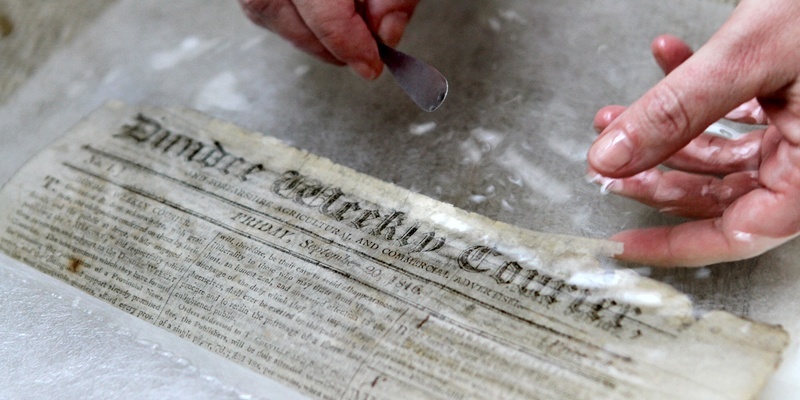The first edition of The Dundee Courier appeared in 1816 and an original copy still exists in the D. C. Thomson archives. Helen Brown spoke to conservator Emma Fraser about preserving this rare piece of newspaper memorabilia.
Interestingly for today’s readers, this original Courier was printed in a form similar to the compact format adopted this year.
This first copy has also survived in better condition than many of the later editions because it is printed on particularly high quality paper, probably handmade from rags rather than wood pulp.
The Dundee Courier that appeared on September 20 1816 was a weekly.
DC Thomson archivist Norman Watson explained: ”The Courier wasn’t the first paper in Dundee there were many previous attempts in the late 18th century and, of course, the Dundee Advertiser from 1801.
”Both it and the weekly Courier were printed by Thomas Colville who was a well-known printer with premises in what is Whitehall Street today.
”The Courier is the one that stood the test of time, however and it was expensive, with a cover price of 7d (about 3p in modern money). It would have been read by the better-off, leisured classes with shared copies in places such as Dundee’s Reading Rooms and gentlemen’s clubs. The literate working classes would have been more or less excluded, although a single copy might go into the mills and be read aloud.
”With the abolition of what was called the ‘tax on knowledge’ in the 1850s, The Courier became the first halfpenny daily paper in Britain and set the standard for cheap, accessible, widely-read newspapers. Eventually, it became the biggest-selling provincial daily in Britain.”
An accredited conservator, Emma studied Fine Arts then trained in London for a masters in paper conservation. She spent over a decade at Dundee University’s renowned Book and Paper Conservation Unit before becoming a freelance conservator.
The first Courier is the oldest newspaper Emma has worked on but is a young thing in comparison with books and manuscripts she has tackled, some dating back to the 1460s.
As an avid fan of Robert Burns, she was also thrilled to work on some of his original manuscripts for the Burns Birthplace Museum in Alloway.
Norman added: ”We’re very fortunate in Dundee to have the world-class book and paper conservators to tackle a project like this. Emma’s skills have allowed us to ensure that this irreplaceable treasure in the D. C. Thomson archive is protected and preserved for the 21st century.”
According to Emma, the conserved paper could be handled now, but only with extreme care. It is currently being stored in a clear, inert polyester sleeve in an archival box. But might it yet be possible for it to fulfil its original purpose and be seen by the public?
Emma added: ”It could be displayed but I would recommend only for short periods and in an environment where the light and relative humidity were controlled.”
Watching someone handle fragile, friable, almost 200-year-old paper is actually quite frightening for the onlooker. Especially when it is being submerged albeit VERY gently in a trough of water. You expect it to disintegrate before your eyes.
But such things hold no fears for book and paper conservator Emma Fraser, who has been working on an original copy of the first Courier from 196 years ago at our Meadowside offices.
It has been washed three times over, for around 30 minutes each time, during a restoration process that has taken many hours of painstaking work. In good old Scottish tap water, too.
”It’s as simple as that!” Emma Fraser explained. ”Often we use de-ionised water and sometimes it’s necessary to check PH levels and acid balances. But Scottish water is good enough for a process like this, warmed slightly to speed up reactions. Water also reinforces the bonds of the fibres of the paper.
”It might look a bit scary but paper is made in water so it’s happy to go back into that medium.”
Of course, prior to its immersion, the newspaper was carefully treated with a special wax cyclododecane to fix the iron gall ink annotations which are vulnerable to further degradation during the aqueous treatments.For more historic newspapers, visit www.britishnewspaperarchive.co.ukThe wax then sublimates basically it evaporates and disappears in a process that takes between two days and two weeks. A 50/50 mix of ethanol and water was also used in a spray to relax the paper before washing in water. Ethanol increases the ”wet-ability” of the paper, making it soak up water more readily which means more effective washing.
Emma said: ”The trickiest part of the project was probably having to apply the cyclododecane wax to the ink before each aqueous treatment. It meant I had to think one step ahead before each stage.
”The copy was also bound into a bigger volume so I disbound it and took it out. The first two issues were bound together with others, adhering at the top, so they had to be separated with great care. Older repairs also had to be removed.
”The newspaper was repaired using a wheat starch paste and a handmade Japanese paper. The mulberry fibres used to make it are very strong but fine so they provide strength without bulk. The newspaper was then humidified again with the ethanol/water spray and pressed between blotters and boards with heavy weights on top.”
Continued…
